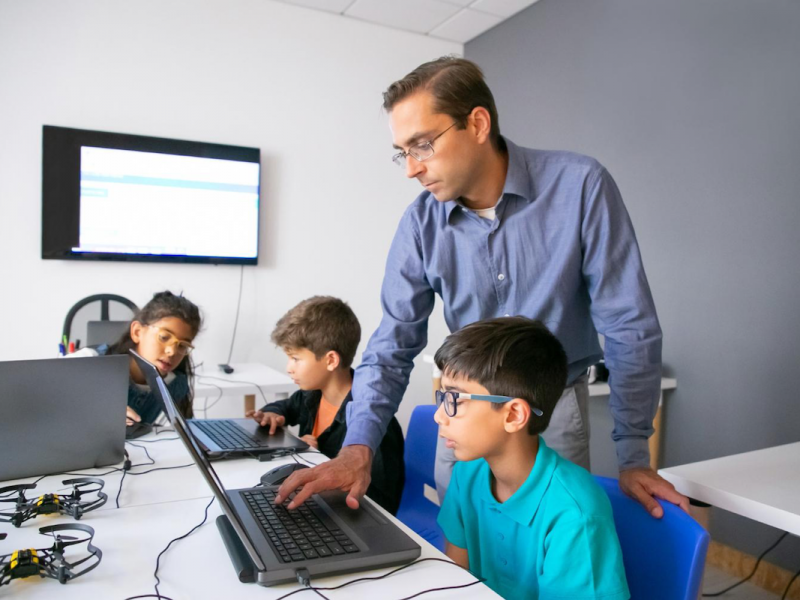Even as Ed-tech becomes the buzzword in these times of virtual classrooms and AI powered assisted learning tools, the future of education is as much dependent on digitization of schools and educational institutes as it is on individual adoption of online learning, across age groups. The pandemic has further highlighted the need for an efficient, digitally enabled and seamless infrastructure for school education. In the decade to come, while there will be several innovations in assisted learning tools and teaching mechanisms.
Listed here are 10 key trends that would be mainstream in a ‘paperless’ school system:
Parent teacher communication: From traditional note in the diary, parent teacher engagement will move to smarter apps which offer an integrated platform for real time communication, school broadcasts, individual parent teacher communication, project announcements, assignment and test schedules, special announcements, test results, as well as offer regular update on student progress. This is set to eventually replace the multiple platforms of communication currently used widely, including WhatsApp, Emails, and handwritten notes in school diaries, which are scattered and may often be missed out by parents.
Digital Fee Collection and Payments: Offering a single window transaction platform for collection of Fees and other financial transactions can help transform the accounting system for schools. Apart from fees, automatic reconciliation, staff salaries, vendor payments, and even special project fees etc. can be operated through a singular window, offering structured, transparent, and updated accounting system.
Enrollment and Admissions Process: This is one of the most time consuming and tedious process for both schools and parents. Digitization of admissions and enrollment processes can not only save a lot of headache and efforts but also help create a transparent and structured solution for student selection. This can be in the form of an app integrated with the school website and can be used for lead management, announcing dates, filling up of online admission forms, submission of proofs, admission fee collection, etc., and can offer end to end enablement.
Centralized Student Information System (SIS): What can be initiated from the time of enrollment, digitization of student information on a centralize cloud based server can help transform the efficacy of education assessment and specialized training for students. From the basics like generating student id-cards, using RFID cards/ facial recognition for attendance, generation of graduation and transfer certificates and alumni management, to keeping a track of academic and extra-curricular progress, spot areas of improvement and identifying core strengths which can be further molded, SIS can be a boon to boost both academic and overall student performance.
Learning Management and Lesson planning: An essential aspect of efficient teaching is learning management and lesson planning, a field that requires a close attention, monitoring, and engagement between principal, teachers, and coordinator. Leveraging relevant tech tools can enable principles/coordinators to create a structured lesson plan at a class/subject/topic/subtopic level for all sections. With all the embedded content at one place, teachers can then implement it, topic by topic, for their relevant classes. This helps teachers to plan better and impart knowledge in a structured manner while also keeping a tab on the overall progress, taking corrective actions wherever there is a slack. It also creates a living document that a school can adhere to year on year without losing any structure/content across years.
Online examination and digital report cards: Transition from physical, on paper examinations to online assessments can help create a more secure, and comprehensive examination format that is focused on understanding of a subject among children. Not only would this help better gauge student potential, it also offers valuable data capture opportunity that can provide analytical insights into improving student performance.
Custom learning supported by Digital Classrooms: While physical classrooms have been a norm, the lockdown has popularized digital classrooms with options to live stream as well as access recorded sessions by teachers. These can be extremely useful in ensuring students never miss out a class, even in case of physical absence and have year-long access to the recorded content that can be accessed on-demand, translating into video notes and credible reference material. This is also helpful for offering one to one sessions with specialist teachers, irrespective of location.
Train the teacher programs: Up-skilling of teachers is one of the most important aspects of ensuring quality education among children. However, this is also one of the most avoided and under-rated aspects of traditional schooling system. Given the academic and administrative roles handled by teachers, it is often difficult for them to find options for regular up-skilling, unless provided by the schools themselves. Digitization can be instrumental in empowering teachers to take up online training programs that are flexible and can be taken up along with regular school activity.
Child safety and security: This is another aspect that has been a prime concern and priority for parents, especially in the light of the post-covid scenario. scenario. From CCTV footage that can monitor social distancing and mask protocols during school hours to streamlining the after school pick-up process for students, integrating technology solutions can help build parent trust and school credibility. Further, the system can be extended to schedule bus transportation, school bus tracking, collect bus driven data, and monitor bus driving speed etc., creating a secure and transparent environment.post-covid. Child safety and security: This is another aspect that has been a prime concern and priority for parents, especially in the light of the
Specialized extra-curricular activity: While the above administrative and operational benefits of digitization at schools can make a drastic improvement in performance, the infrastructure can be useful to provide students a supportive framework for other technology enabled extra-curricular activities. From daily/ weekly talent showcase or video based debate/ elocution competitions, the digitally equipped school infrastructure can help in specialized projects around AI and robotics, and machine learning which can help build their cognitive understanding.
Equipped with policy support and a fast evolving digital infrastructure across the country, B2B digital adoption for education is expected to transform the K-12 education system on several levels. The paperless schooling as a norm may take a few years to become mainstream, but the benefits and the ease of use are already creating curiosity, with many schools already enabling some or most of these features on their campuses.
This article is written by Ashish Chaturvedi, Founder, SchoolDiary and was first published in ‘IndiaToday’ on Oct 14,2020


